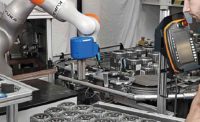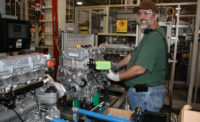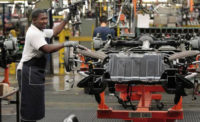Thinking outside the box” is a metaphor that means to think differently, unconventionally or from a new perspective. To think outside the box is to look farther—to avoid thinking of the obvious solutions to a problem and to try to come up with new alternatives.
During a recent retooling project at the General Motors power train assembly plant in Toledo, OH, that business cliché took on a literal, as well as a figural, meaning.
Founded in 1916 and employing some 1,900 people, the factory assembles both rear-wheel drive and front-wheel drive transmissions. Since February 2006, GM has invested more than $1.2 billion in the facility.
In 2010, the automaker embarked on a project to boost production of six-speed transmissions, particularly the new, fuel-efficient GF6 product, which was designed for small cars like the Chevrolet Malibu and Cruze. The goal was to produce more than 2,200 units per day.
In revamping the GF6 production line, GM engineers wanted to improve workflows, improve changeovers, reduce reprogramming, and prevent the curse of all automated manufacturing lines—situations in which one malfunctioning machine causes the entire line to shut down. GM engineers also wanted to minimize maintenance time by installing PLCs, drives and pallet-recognition devices outside of the conventional cabinetry found on traditional assembly lines. And, they wanted to distribute controllers throughout the line and thereby substantially increase system flexibility.
GM completed the project with the help of Siemens Industry and software provider eFlex Systems Inc. Siemens provided the PLC, CNC system, human-machine interfaces, radio frequency identification (RFID) system, and its high-level Ethernet protocol, Profinet, to run on the GM network. Overlaying this hardware and communications topology was the Flexible Assembly Configuration System (FACS) from eFlex Systems.
Siemens customized the latter to create SIFACS, which fully integrated the control elements of every assembly and test station. SIFACS largely focused on integrating the core PLC software blocks and functionalities of the individual stations with the information coming to and from the RFID tags on each workpiece pallet.
An Integrated Approach
In an auto plant, flexibility is a key attribute of any automated assembly system. All hardware and software must be designed with deterministic functionality. By creating a decentralized control network that was nonetheless in harmony with the overall workflow of the plant, GM and Siemens devised a modular, yet flexible, architecture for the entire system. This integrated automation approach not only addressed multiple families of machines, it also coordinated all code development, safety and communications functions into a seamless, interdependent, yet highly adaptive, control scheme.
This integration is visible in the modular and open controller and I/O rack assemblies located throughout the facility. They consist of a Siemens Simatic S7 PLC, a Siemens safety-integrated drives platform, and all I/O, including antennas for reading RFID tags.
System diagnostics are similarly integrated. “We devised premade templates and blocks important to the power train build process as our starting point,” says Siemens consultant Matthew Thornton. “With all motion and safety functions integrated into the drives, there was no need to build a separate troubleshooting architecture for what would be a more traditional safety network of relay cabinetry.”
Only a few components talk on the Profibus system. All other I/O and automation components communicate over Profinet.
Siemens and eFlex Systems worked closely together on the project. “They provided the configuration and monitoring system, while we provided the automation run-time system,” explains Reinhold Niesing, engineering manager at Siemens Industry. “Both systems needed to run in sync to provide GM with configurable options, when changes in production or manufacturing enhancements were needed.”
Their collaboration enabled operational, visualization and diagnostic functions to be streamlined in a consistent control scheme—the Transline HMI Lite CE package. This package provides a uniform user interface for operational and diagnostic functions on the vast majority of machine tools, transfer lines, robots, assembly machines, sensors and vision systems throughout the entire facility.
“The best part is that the package can be customized to meet specific user needs and preferences,” explains Michael Grass, project manager for Siemens. “It provides useful information to our SIFACS system of configurable assembly automation. The two systems complement each other quite well.”
RFID Gets Things Started
Most transmission parts are delivered to the production line via automatic guided vehicles. Each transmission travels through the line on a pallet equipped with an RFID tag. Information is sent to and from the tag on the fly, without any line stoppage.
“The key here is the data throughput in the system, as it directly impacts cycle time,” says Niesing. “The tags must be able to function in static mode, whereby the data on the part is read before the process begins. Model number, serial number and build status information are all contained in the tag. The faster we read the information, the faster the process begins.”
In some RFID applications, the signal from a tag can degrade over time. Not so with the system installed at GM. The Siemens system supports two interface protocols: ISO 15693 (an open standard) and a proprietary standard, Simatic RF300. The latter uses a state-of-the-art chip optimized to achieve faster read-write rates. The system can handle large amounts of data (64 kilobytes) in fast cycle times.
A key aspect of the system is that each RFID tag has both EEPROM and FRAM. The 20-byte EEPROM is designed to be a one-time programmable memory chip, a security feature that was deemed most desirable by GM for this application. The FRAM can be written and rewritten many times.
The RFID system communicates easily over the existing Profinet, Profibus and other common protocols.
Through a decentralized and cabinet-less design, GM achieves highly integrated RFID control with easy access and true out-of-the-box equipment for the line’s control architecture. Profinet provides GM with a high-performance, reliable network with minimum bandwidth impact or additional network load. No special hardware is required.
Logic Blocks All Around
The overall thrust of the line development was to have consistent, even identical, logic blocks at every station, says George Jewell, who served as assembly controls team leader at GM during the project and who is now vice president of eFlex Systems.
This would allow immediate successive modifications to be made in machining or assembly operations throughout the line. When rebalancing was needed, when an upturn or downturn in production was required, or when an entirely new model came onto the line, changeover could happen in hours, rather than in weeks, as was the industry norm.
By standardizing on the hardware, software and communication protocols, engineering costs could be contained. In addition, maintenance is much more efficient, since much of the system hardware is exposed on the line, rather than enclosed in electrical cabinets.
From the utility perspective, the run-time component of the system can function without the entire system being online—a benefit of a decentralized architecture. “Siemens’ commitment to provide this value-added functionality geared towards flexibility…has substantially supported GM Powertrain’s efforts to standardize processes, controls and continuously improve,” says Bob Raven, GM controls manager.
Currently, GM uses FACS at various plants in Mexico, China, India, Thailand, Korea and the United States for the production of transmissions, engines and even the generator on the new Chevy Volt. Plans call for the technology to be implemented at GM facilities in Canada and Eastern Europe, as well.
Rather than the typical product life cycle management software, Jewell sees FACS as more of a production line life cycle management tool. Its inherent adaptability means common hardware can be made to do diverse tasks, at varying rates, with on-the-fly changeover, in less time than previously possible.
Typical Station Dynamics
Most of the transmission subassemblies are produced on automated assembly stations. Adding a station simply requires adding the process devices, a PLC with standard SIFACS logic, and downloading a FACS configuration. In contrast to traditional zone control, this reconfiguration is not a building block concept. Rather, the instructions affect the entire line.
In contrast, all manual workstations on the line get the same download received to a PLC. While not reliant on the server network in a deterministic mode, the manual stations nonetheless utilize the same software to execute quick tooling changes, machine sequence variations, line balancing and report tracking.
Whether it’s a manual or automated process, all build histories, troubleshooting and machine debugging are recorded for later analysis.
CNC Controls Every Step
CNC technology is used for most of the metal-cutting processes at the plant, mostly in the forming, hobbing, grinding and finishing of the gears and splines. Most of the machines are controlled by Sinumerik 840D, the highest-level CNC offered by Siemens. The control governs the cutting theater of the machines, and it also coordinates all the movements into and out of the machine. For example, ring gears cut on a Wera Profilator machine are indexed from one station to the next, in timed sequences, to coordinate with predetermined production requirements. This operation occurs completely automatically, requiring no operator intervention, except for maintenance and planned inspections.
Likewise, each step of the process in the machining of valve bodies and transmission cases is controlled by CNC. The components are produced in the correct sequence for subsequent assembly and testing operations. During those operations, other motion control devices and software execute, monitor and control the assembly process.
Safety First
Safety features are numerous on the line, resulting in a complete failsafe system across all PLCs, I/O devices and safety-integrated drives. All safety devices are networked via the Profisafe protocol, a certified safety network, eliminating time-consuming and difficult-to-maintain hard-wired safety connections.
All safe I/O and failsafe drives are part of the Siemens Totally Integrated Automation (TIA) protocol. Since it is fully integrated, this protocol provides comprehensive system diagnostics, which helps to guide maintenance staff to the exact fault location and mitigate downtime. Since the drives, starters and machine safety are integrated into the multifunctional machine-mounted I/O system, the overall engineering complexity is reduced.
For service requirements in the event of a fault, hot swapping of an I/O module is possible during operation, without switching off the entire station. The I/O modules and other equipment are protected to IP65 and IP67 standards. Enclosures were not required, which helped reduce the total cost of the project.
“We’ve seen great results,” says Jewell. “Activities that once took months were reduced to weeks, and what took weeks was reduced to hours. There’s less ramp-up time, and the changeover and line-balancing features are already proving this was a beneficial investment.”
Custom Software Ensures Flexible Assembly
Working with GM process specialists, Siemens customized eFlex Systems’ FACS software to create SIFACS, a software platform that integrates the host IT system at the Toledo plant with all the hardware and software on the line.
SIFACS is the hub of the information management system for the transmission production line. It coordinates all demand input from the GM server and FACS configuration stations, and it transmits data and commands via a Profinet communications network to all the PLCs, HMIs, motor starters, frequency converters, safety-integrated drives and other controls at the various machining, assembly and test stations.
SIFACS also captures all the data fed back from RFID tags, smart sensors, RS-232 interfaces, hand scanners and other I/O devices.
This enables engineers to closely control output. It also enables line stations themselves to be reconfigured, using a unique Siemens micro memory card. All PLC logic, hardware configuration and process data are embedded on the card, which is interfaced to three Ethernet ports and one Profibus port for instant communications. A PC is not needed.
The Simatic control systems executing motion commands read from RFID devices at a rate of 8,000 bytes per second, exceeding the ISO 15693 standards for read and write performance.
HMI screens equipped with Cognex Vision View permit constant monitoring by both a team leader and a conveyor controller, eliminating the need for a PC dedicated to a vision system.
All the smart devices on the line are also interfaced to the SIFACS platform, including fastening equipment, leak testers, presses, bar code readers and printers, robots, vision systems and protocol gateways.
Data from various processes are fed to andon boards for display on the line.
The FACS software provides process improvement and efficiency tools, enabling engineers to collect data and fine-tune the system in real time. Build status and cycle time information is always current. Line and station balancing can likewise be accomplished on the fly. Calculations of process efficiency, loading times, cycle times, and process times can be made, charted, displayed and analyzed by the team leader or station control personnel.
Facts: GM Power Train Assembly Plant
Founded in 1916, GM’s power train assembly plant in Toledo, OH, spans 2 million square feet on 151 acres.
During World War II, the plant produced truck transfer cases and transmissions for four- and six-wheel-drive military trucks. Today, the factory produces GM’s fuel-efficient Hydra-matic 6L50, 6L80 and 6L90 rear-wheel-drive transmissions, as well as the global 6T40 front-wheel-drive, six-speed transmission.
The plant ships rear-wheel drive transmissions GM assembly plants in Arlington, TX; Bowling Green, KY; Fort Wayne, IN; Flint, MI; Wentzville, MO; and Oshawa, ON. Front-wheel-drive transmissions are shipped to Fairfax, KS; Lordstown, OH; Oshawa, ON; and Lake Orion, MI.
During the past few years, GM has invested more than $1 billion in the facility:
December 2013: $30.6 million to increase production of six-speed transmissions.
June 2011: $82 million to enhance production of eight-speed transmissions.
May 2011: $240 million to produce a new eight-speed transmission.
May 2007: $323 million to produce six-speed, front-wheel-drive transmissions.
February 2006: $540 million to produce six-speed, rear-wheel-drive transmissions.
“[These investments] signify a commitment to the men and women of Toledo power train and their dedication to build the world’s best transmissions. The entire workforce exhibits a sense of ownership and pride in the transmissions they build,” says Joe Choate, plant manager.



















